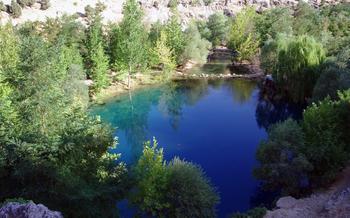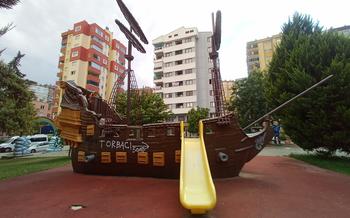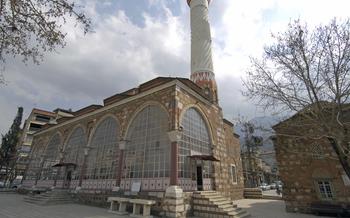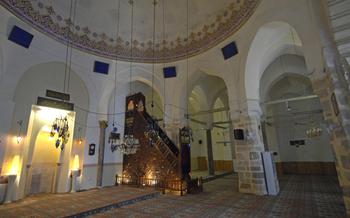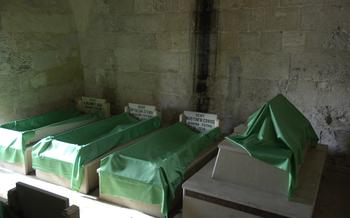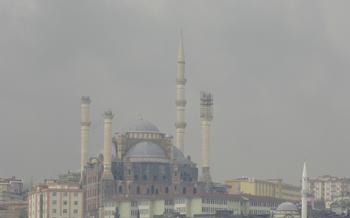
Ulu Camii (The Grand Mosque)
- The Ulu Camii (The Grand Mosque): A Majestic Landmark
- Location and Accessibility
- Architectural Splendor
- Historical Significance
- Prayer Hall and Minaret
- Religious Significance
- Cultural Importance
- Photography and Memories
- Local Traditions and Customs
- The Surrounding Area: Unveiling Kahramanmaraş's Vibrancy
- The Call to Prayer: A Soul-Stirring Experience
- Suggested Itinerary
- Local Festivals and Events
The Ulu Camii (The Grand Mosque): A Majestic Landmark
Situated in) stands as a testament to the city's rich history and architectural prowess. Constructed in the 12th century during the Seljuk era, this magnificent mosque has served as a religious and community center for centuries, witnessing the ebb and flow of history and embodying the resilience of the city. The Ulu Camii, with its blend of Seljuk and Ottoman architectural styles, intricate carvings, and stunning tilework, is not just a place of worship but also a symbol of Kahramanmaraş's cultural heritage and national pride.
Location and Accessibility
The Ulu Camii stands tall in the heart of Kahramanmaraş, Turkey, at the corner of Kurtuluş Street and Fevzi Çakmak Boulevard. Its prominent location makes it a significant landmark and a symbol of the city's rich history. Reaching the mosque is quite convenient, whether you choose to explore on foot or utilize public transportation.
For those who prefer a leisurely stroll, the Ulu Camii is within easy walking distance from many hotels, restaurants, and shops in the city center. Take a pleasant walk through the vibrant streets, soaking in the local atmosphere as you make your way to this majestic landmark.
Alternatively, Kahramanmaraş offers a reliable public transportation system that connects various parts of the city. Several bus lines stop near the Ulu Camii, making it accessible from different neighborhoods. Look for buses with routes that pass by the city center or the Ulu Camii stop.
Once you arrive in the vicinity of the mosque, you'll be captivated by its grandeur and architectural beauty. Its towering minaret and intricate facade beckon you to explore this iconic symbol of Kahramanmaraş's heritage.
Architectural Splendor
The Ulu Camii stands as a testament to the architectural brilliance of the Seljuk and Ottoman periods. Its unique design elements, intricate carvings, calligraphy, and tilework make it a masterpiece of Islamic architecture. The mosque's exterior is adorned with beautiful stone carvings and decorative elements, while the interior features a stunning array of colorful tiles and intricate calligraphy. The harmonious blending of these architectural styles creates a visually captivating spectacle that draws visitors from around the world.
The Ulu Camii's prayer hall is particularly impressive, with its vast space and elegant design. The interior is supported by a series of massive columns and arches, creating a sense of grandeur and spaciousness. The walls and ceilings are adorned with intricate carvings and calligraphy, adding a touch of artistic beauty to the sacred space. The towering minaret, a symbol of Islamic faith and devotion, stands proudly beside the mosque, its elegant silhouette visible from miles away.
Historical Significance
The Ulu Camii, with its grand stature and intricate design, stands as a testament to Kahramanmaraş's rich history. Its construction dates back to the 12th century, during the reign of the Seljuk dynasty, a period marked by architectural innovation and cultural flourishing. The mosque served as a central religious and community hub, hosting congregational prayers, Quranic studies, and social gatherings. Over the centuries, the Ulu Camii has witnessed the city's transformation, from a small settlement to a prosperous trading center. It has endured numerous challenges, including earthquakes and invasions, yet its resilience and enduring beauty have ensured its place as a symbol of Kahramanmaraş's indomitable spirit.
Prayer Hall and Minaret
The Ulu Camii's prayer hall is a vast and awe-inspiring space, designed to accommodate a substantial number of worshipers. Its layout is characterized by rows upon rows of intricately patterned carpets, creating a sense of order and tranquility. The interior is adorned with elegant chandeliers, casting a warm glow over the serene atmosphere.
The mihrab, or prayer niche, is the focal point of the hall, indicating the direction of Mecca. It is meticulously crafted with intricate carvings and tilework, showcasing the mosque's artistic prowess. The minbar, or pulpit, is another significant feature, where the imam delivers sermons and religious teachings. Its design harmonizes with the overall aesthetics of the mosque, blending seamlessly with the surrounding elements.
Towering over the prayer hall is the majestic minaret of the Ulu Camii. Its slender form rises gracefully towards the heavens, visible from various points in the city. The minaret's intricate balcony, adorned with decorative elements, provides a breathtaking view of the surrounding cityscape. The call to prayer, or Adhan, reverberates through the city from this elevated vantage point, echoing the mosque's role as a spiritual beacon for the community.
Religious Significance
Ulu Camii, standing as a beacon of Islamic faith, serves as a central place of worship for the Muslim community in Kahramanmaraş. Its spacious prayer hall hosts regular congregational prayers, where devotees gather to fulfill their religious obligations and seek spiritual connection. The mosque's serene ambiance fosters a sense of unity and brotherhood among worshippers, who come together to pray, share religious teachings, and celebrate Islamic festivals.
During the holy month of Ramadan, the mosque transforms into a vibrant hub of religious activity. Special prayers, known as Tarawih, are held after the evening prayers, and the mosque remains open throughout the night, allowing worshippers to engage in extended prayers and recitations. The atmosphere during Ramadan is particularly captivating, with the mosque reverberating with the melodious chanting of the Quran and the communal recitation of supplications.
Beyond its role as a place of worship, the Ulu Camii also serves as a center for Islamic learning and scholarship. Religious classes and seminars are often conducted within its premises, providing a platform for the dissemination of Islamic knowledge and fostering a deeper understanding of the faith. The mosque's rich history and its association with renowned religious figures have further cemented its status as a significant religious landmark in Kahramanmaraş.
Cultural Importance
Ulu Camii: A Symbol of Turkish Identity
The Ulu Camii is not merely a religious edifice; it is a profound symbol of Turkish culture, deeply intertwined with the nation's history, traditions, and identity. This magnificent mosque embodies the harmonious fusion of Islamic and Turkish elements, reflecting the rich cultural tapestry that defines Turkey.
The mosque's architectural style, a blend of Seljuk and Ottoman influences, showcases the evolution of Turkish architecture over centuries. Its intricate carvings, calligraphy, and tilework narrate tales of Turkish craftsmanship and artistry, while its towering minaret stands as a testament to the country's Islamic heritage.
Beyond its physical presence, the Ulu Camii serves as a spiritual and cultural hub for the people of Kahramanmaraş. It is a place where the community gathers for prayers, celebrations, and religious teachings, fostering a sense of unity and belonging. The mosque's cultural significance extends beyond the Muslim community, as it attracts visitors from all walks of life who come to admire its architectural beauty and learn about its historical importance.
The Ulu Camii is a symbol of national pride, representing Turkey's rich cultural heritage and its commitment to preserving its traditions. It is a living testament to the enduring spirit of the Turkish people, who have safeguarded and cherished this architectural masterpiece for centuries.
Photography and Memories
Capturing the Essence of the Ulu Camii through Photography
The Ulu Camii, with its architectural grandeur and spiritual ambiance, offers a captivating subject for photography enthusiasts. While capturing the mosque's beauty, it is essential to respect the sanctity of the place. Visitors are permitted to take photographs in designated areas, ensuring they do not disrupt the religious activities or disturb the worshippers.
Beyond capturing the mosque's physical beauty, photography can serve as a means of preserving memories and documenting a spiritual journey. Whether you're a professional photographer seeking the perfect shot or a traveler documenting your experiences, the Ulu Camii provides ample opportunities to create lasting memories.
Tips for Meaningful Photography:
-
Respectful Approach: Remember that the Ulu Camii is an active place of worship. Be mindful of worshippers and avoid taking photographs that may disrupt their prayers or invade their privacy.
-
Composition and Lighting: Experiment with different angles and lighting conditions to capture the mosque's intricate details and the play of light on its surfaces.
-
Storytelling Through Images: Compose photographs that tell a story about the mosque, its people, and its significance. Capture the emotions, interactions, and spiritual atmosphere that make the Ulu Camii a unique and cherished landmark.
-
Preserving Memories: Whether you share your photographs online or keep them as personal keepsakes, they will serve as a reminder of your visit to this awe-inspiring mosque and the memories you created in Kahramanmaraş.
Local Traditions and Customs
When visiting the Ulu Camii, it is essential to be mindful of local customs and traditions to ensure a respectful and meaningful experience. As a place of worship, the mosque holds significant religious and cultural significance for the community. Visitors should dress modestly, covering their shoulders and knees, and remove their shoes before entering the prayer hall. Maintaining a quiet and reverent demeanor is expected, and avoiding loud conversations or disruptive behavior is essential. Photography is generally permitted in designated areas, but it is crucial to be respectful and avoid capturing images of individuals engaged in prayer. By observing local customs and interacting with the community courteously, visitors can foster cross-cultural understanding and create a positive and welcoming atmosphere.
The Surrounding Area: Unveiling Kahramanmaraş's Vibrancy
Beyond the Ulu Camii's hallowed walls lies a vibrant neighborhood teeming with life and local charm. Stroll through the bustling streets, where the air is filled with the enticing aromas of traditional Turkish cuisine wafting from nearby restaurants. Discover hidden gems such as the Kahramanmaraş Castle, a testament to the city's rich history, or the atmospheric Grand Bazaar, where you can immerse yourself in the vibrant tapestry of Turkish culture.
Take a leisurely break at one of the many charming cafes, sipping on aromatic Turkish coffee while savoring the sweet melodies of traditional music. Engage with the friendly locals, who are always eager to share stories and insights into their beloved city. Indulge in the delectable local cuisine, from mouthwatering kebabs to melt-in-your-mouth desserts, tantalizing your taste buds with the flavors of Kahramanmaraş.
As the sun begins to set, the neighborhood transforms into a kaleidoscope of colors, with the Ulu Camii's majestic silhouette casting a warm glow over the surrounding area. Experience the magic of Kahramanmaraş, where the spiritual and cultural essence of Turkey intertwine, creating an unforgettable journey for the senses.
The Call to Prayer: A Soul-Stirring Experience
The Adhan, or call to prayer, is an integral part of Islamic culture. It is a melodious intonation that summons the faithful to prayer five times a day. In Kahramanmaraş, the Adhan holds a special significance, echoing through the streets from the minarets of the Ulu Camii.
The Adhan is not merely a call to prayer; it is a declaration of faith, a reminder of the presence of the divine. Its melodic verses, chanted in Arabic, resonate through the city, creating a profound spiritual atmosphere.
For visitors to Kahramanmaraş, experiencing the Adhan is a unique and awe-inspiring moment. The melodious chanting, coupled with the stunning backdrop of the Ulu Camii, creates a lasting impression. It offers a glimpse into the deep devotion and faith that permeate the city.
Beyond its religious significance, the Adhan also serves as a cultural touchpoint. It is a reminder of the rich Islamic heritage of Kahramanmaraş and its people. The harmonious blend of voices, echoing through the city, creates a sense of unity and community among the faithful.
For travelers seeking an authentic and immersive experience, listening to the Adhan in Kahramanmaraş is a must. It is a moment to pause, reflect, and soak in the spiritual essence of this vibrant city.
Suggested Itinerary
A visit to the Ulu Camii can be combined with other nearby attractions to create a comprehensive experience of Kahramanmaraş's history and culture.
-
Start your journey at the Ulu Camii, immersing yourself in its architectural splendor and religious significance.
-
Proceed to the Kahramanmaraş Museum, located just a short walk away, to delve into the region's rich past and explore its diverse collection of artifacts.
-
In the afternoon, wander through the vibrant streets of the old city, discovering hidden gems and indulging in local delicacies at the traditional markets and cafes.
-
As the sun begins to set, make your way to the top of Kahramanmaraş Castle, capturing breathtaking panoramic views of the city and its surroundings.
-
Conclude your day with a delightful dinner at one of the local restaurants, savoring the flavors of traditional Turkish cuisine.
Local Festivals and Events
Enhance your visit to the Ulu Camii by aligning it with one of the many vibrant festivals or events that take place in Kahramanmaraş throughout the year. These celebrations offer a unique opportunity to immerse yourself in the city's rich culture and traditions. From traditional Turkish music concerts and dance performances to colorful street processions and local bazaars, there's always something special happening in this dynamic city.
One of the most notable events is the annual Kahramanmaraş Sütçü İmam Festival, which honors the legendary figure of Sütçü İmam, who is believed to have invented the famous Turkish ice cream, Maraş dondurması. During the festival, the streets come alive with music, dance, and an abundance of delicious ice cream, creating a festive atmosphere that attracts visitors from far and wide.
Timing your visit to coincide with one of these local festivals will not only provide a more comprehensive and memorable experience but also allow you to connect with the local community and gain a deeper understanding of Turkish culture. Embrace the spirit of celebration and let Kahramanmaraş enchant you with its unique blend of history, tradition, and vibrant festivities.

